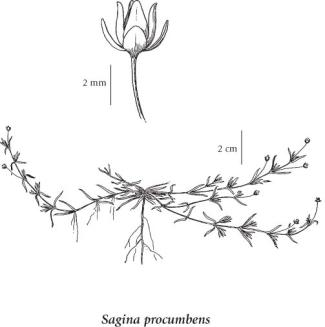Sagina procumbens L.
bird's-eye pearlwort (birdeye pearlwort)
Caryophyllaceae (Pink family)
Introduction to Vascular Plants
bird's-eye pearlwort (birdeye pearlwort)
Caryophyllaceae (Pink family)
Introduction to Vascular Plants
Species Information
General:
Biennial or perennial (sometimes flowering the first year) herb from a taproot and freely rooting stems; stems prostrate, several, branched, glabrous, 2-20 cm long.
Leaves:
Basal leaves 1-2.5 cm long, numerous in a dense persistent rosette; stem leaves opposite, usually linear, needle-pointed, 5-12 mm long, the upper ones sometimes minutely fringed, 2 to several of the pairs usually with secondary leaves clustered in their axils; stipules lacking.
Flowers:
Inflorescence of usually 2 to several flowers per stem; petals 4 or sometimes 5, less than 1 mm long or lacking; sepals 5 or more usually 4, egg-shaped, 1.5-2.5 mm long, spreading at time of capsules opening.
Fruits:
Capsules egg-shaped, 2-5 mm long, 4- or 5-valved; seeds about 0.3 mm long, not shiny.
Illustration

If more than one illustration is available for a species (e.g., separate illustrations were provided for two subspecies) then links to the separate images will be provided below. Note that individual subspecies or varietal illustrations are not always available.
Illustration Source: The Illustrated Flora of British Columbia
Ecology
Ecological Framework for Sagina procumbens
The table below shows the species-specific information calculated from
original data (BEC database) provided by the BC Ministry of Forests and Range.
(Updated August, 2013)
The table below shows the species-specific information calculated from
original data (BEC database) provided by the BC Ministry of Forests and Range.
(Updated August, 2013)
| Site Information |
Value / Class |
||
|
Avg |
Min |
Max |
|
| Elevation
(metres) |
850 | 850 | 850 |
| Slope
Gradient (%) |
20 | 1 | 40 |
|
Aspect (degrees) |
225 | 226 | 226 |
| Soil
Moisture Regime (SMR) [0 - very xeric; 4 - mesic; 8 - hydric] |
3 | 3 | 3 |
| Modal
Nutrient Regime
Class |
D | ||
| #
of field plots species was recorded in: |
2 | ||
| Modal
BEC Zone Class |
IDF | ||
|
All BEC Zones (# of stations/zone) species was recorded in |
IDF(2) | ||
|
Source:
Klinkenberg 2013
|
|||
Habitat and Range
Wet to moist roadsides, lawns, coastal cliffs and pond margins in the lowland and steppe zones; common in SW BC, less frequent northward along the coast and in SC BC; N to AK, E to NF and S to MI, MN, UT, CA and MX.Status Information
Synonyms
Synonyms and Alternate Names:
Sagina procumbens var. compacta Lange